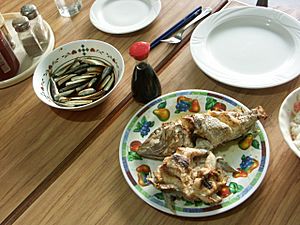Marshallese cuisine facts for kids
The Marshallese cuisine is all about the yummy foods, drinks, and cooking traditions of the Marshall Islands. Imagine a mix of fresh, local ingredients and some foods brought in from other places. People there often eat things like breadfruit, coconuts, bananas, and lots of seafood. They also enjoy rice and flour, which are imported. For a long time, people in the Marshall Islands have known how to keep food fresh for a long time, and they still do this today!
Common Foods & Delicious Dishes
When you visit the Marshall Islands, you'll find many tasty foods. Some popular ones include breadfruit, bananas, and coconuts. People also eat papaya, rice (sometimes as sticky rice balls), and lots of seafood. You might see fried fish, coconut crab, chicken, pork, and clams. Sometimes, people even eat sashimi (raw fish) or sea turtles. And of course, fresh coconut water is a favorite drink!
Fish and breadfruit are super important foods here. On average, a person in the Marshall Islands eats about 240 pounds of fish every year! Fishing is a huge part of life, and there are more than 50 different words in the Marshallese language just for fishing methods! Some foods like rice, flour, sugar, and tea are brought in from other countries. These imported items often add to or complete meals made with local foods.
Traditional Meals, Customs & Celebrations
Food is a big deal during parties and special events in the Marshall Islands. It's a tradition to offer food to the Iroij, who are the important chiefs. This shows them respect and honor.
Some very old and traditional foods include pandanus fruit and breadfruit. One special breadfruit dish is called bwiro. It's made from breadfruit paste that has been fermented (left to change over time). Then, it's wrapped in banana leaves and cooked in an underground oven. Roasted breadfruit and mashed taro root are also traditional. Another important product is copra, which is the dried inside part of a coconut. It's a major export and is pressed to make oil.
A kemem is a special party held when a child turns one year old. At these parties, lots of different Marshallese foods are served. It's also a custom for guests to take a household item from the party host's home. In Marshallese culture, if a family has fewer things left after the kemem, it can show how generous they are!
Keeping Food Fresh: Preservation Methods
Food preservation has always been a key part of Marshallese culture. It helps make sure there's enough food for everyone, which is called food security. People still preserve food today, though maybe not as much as in the past.
For example, people on the northern Ratak Chain islands like Ailuk, Likiep, and Mejit still make a dried pandanus paste called mokwan. On the Ralik Chain islands such as Ujae, Lae, and Wotho, they call it jããnkun. If this pandanus paste is made correctly, it can be stored and eaten for many years! The fermented breadfruit dish, bwiro, can also be kept fresh for a long time, sometimes for many months, without going bad.



